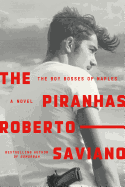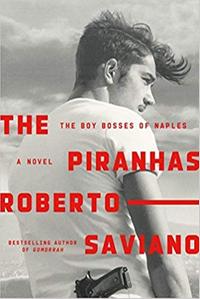
 Italian author Roberto Saviano is probably best known for his nonfiction book Gomorrah, which was adapted into an acclaimed film as well as a television series. That daring investigation of a powerful Neapolitan criminal organization resulted in threats on Saviano's life and the need for a permanent police escort. In The Piranhas: The Boy Bosses of Naples, Saviano turns to fiction to take another look at Neapolitan crime, this time focusing on the real-life phenomenon of youth gangs, or paranze, wreaking havoc in the city. He prefaces the novel with a short statement: "What you are about to read actually occurred. Facts have been modified and connected to others in order to make a violent and complex world more comprehensible...." The Piranhas is all the more disturbing for this basis in real events.
Italian author Roberto Saviano is probably best known for his nonfiction book Gomorrah, which was adapted into an acclaimed film as well as a television series. That daring investigation of a powerful Neapolitan criminal organization resulted in threats on Saviano's life and the need for a permanent police escort. In The Piranhas: The Boy Bosses of Naples, Saviano turns to fiction to take another look at Neapolitan crime, this time focusing on the real-life phenomenon of youth gangs, or paranze, wreaking havoc in the city. He prefaces the novel with a short statement: "What you are about to read actually occurred. Facts have been modified and connected to others in order to make a violent and complex world more comprehensible...." The Piranhas is all the more disturbing for this basis in real events.Nicolas Fiorillo, the 15-year-old protagonist of The Piranhas, is introduced to the reader in a scene where he perpetrates an act of grotesque bullying on another boy for liking pictures of Nicolas's girlfriend on social media. He and his friends from the slums of Naples are preoccupied by symbols of wealth and status, online and off, obsessing over shoes and girls. They quickly find themselves enlisted as small-time drug dealers for one of the established gangs operating out of Naples. Nicolas is restless, however, and when a shake-up leaves them without a backer, he decides to start a paranza of his own.
Saviano and his translator, Antony Shugaar, use the nuances of language to reflect on the culture that produces gangs of violent young boys. For example, paranza refers not just to gangs but to the "boats that go out to catch fish through the trickery of light. The new sun is electric, the light occupies the water, it takes possession of it, and the fish come looking for it." The boys are seduced by the gangster lifestyle and are alienated from their parents--for them, easy money, drugs and power prove far more attractive than hard work or education. Another word with multiple meanings is vattere, which in the Neapolitan dialect does not mean just to "beat up" but to "vatte with all the force he possesses, with genuine resentment and without any rules." Before long, Nicolas's paranza has acquired an arsenal of guns and moved on to armed robbery and racketeering.
The Piranhas contains scenes of violence that are shocking not just in their ferocity but for the youth and immaturity of the perpetrators. The gangsters of this novel are children who carry out crimes in between rounds of PlayStation. They obsessively mimic depictions of wrongdoing from popular culture, reenacting scenes from movies. In one discussion of how to punish a gang member, another member suggests: "let's cut off his ears like in Reservoir Dogs, when they cut the ear off the policeman." In the imagination of the teen paranza, real-life violence and fictional depictions mingle dangerously. Saviano paints a portrait of youthful disaffection and misguided priorities, ending in tragedy as daisy chains of violent acts reach their inevitable conclusions. --Hank Stephenson, bookseller, Flyleaf Books, Chapel Hill, N.C.
Shelf Talker: By the author of Gomorrah, The Piranhas is a fictionalized retelling of real-life events involving a 15-year-old who starts a gang of teenage boys that terrorize Naples.

